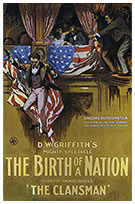
It would appear that LH saw this epoch-making silent when he was helping to run a film society at school, probably around 1943, at the age of about fourteen -
‘The school film society, which had flourished briefly before the war to show GPO Film Unit documentaries which were made available to schools at no charge, resurfaced during hostilities and was operated initially by Mr Higginson, the art master, who loaned his 16mm projector for shows in the library after school, and taught me to operate it in case he got bored.’

After a few disappointments the society was in danger of being cancelled, but...
‘We earned a reprieve because our attraction for the following month was D. W. Griffith’s epic The Birth of a Nation. As treasurer and chief assistant projectionist I had cast my vote in favour of this ambitious booking, which was to be shown in the evening because a few parents and teachers had said they might come.’
It turned out to be a surprise success:
‘Our maximum attendance was usually fifty people, but on this occasion we thought forty chairs would be ample... to our astonishment more than two hundred people stormed the doors, including the local press and teachers from other schools. We had to move the projector back through the double doorway and consequently endure a smaller image; even then people were practically sitting on other people’s knees.’
In terms of its epic sweep, Griffith’s groundbreaking Civil War story is still highly watchable. However, its morals are quite simply abominable by any modern standards, as the film depicts the proud knights of the Ku Klux Klan riding in on horseback to save decent white folk from the scourge of the ‘negro’. The final scene has them deliberately preventing black people from voting in an election, so as to ensure their complete alienation from society.
‘…few of us quite understood how Griffith could see the Ku Klux Klan as the heroes of this picture, or why the ‘dastardly negroes’ were played by white men in blackface.’
Halliwell |
| The Birth of a Nation |